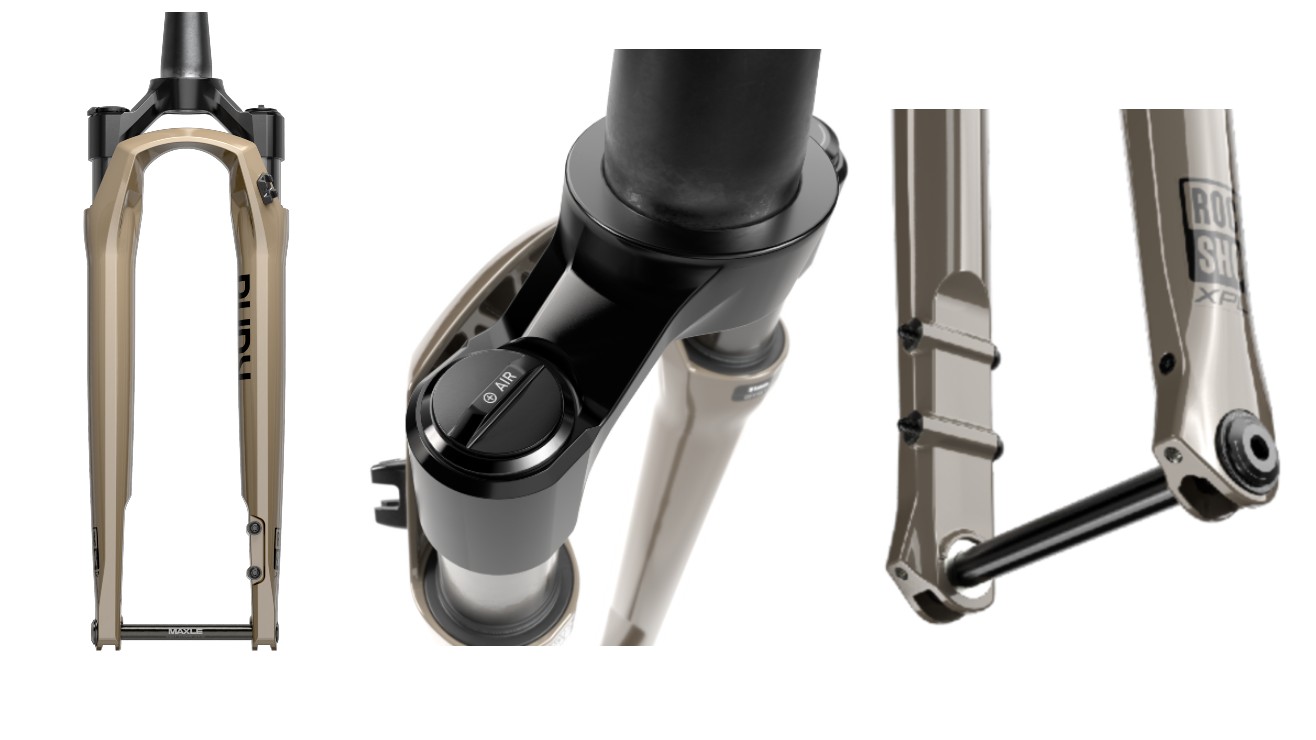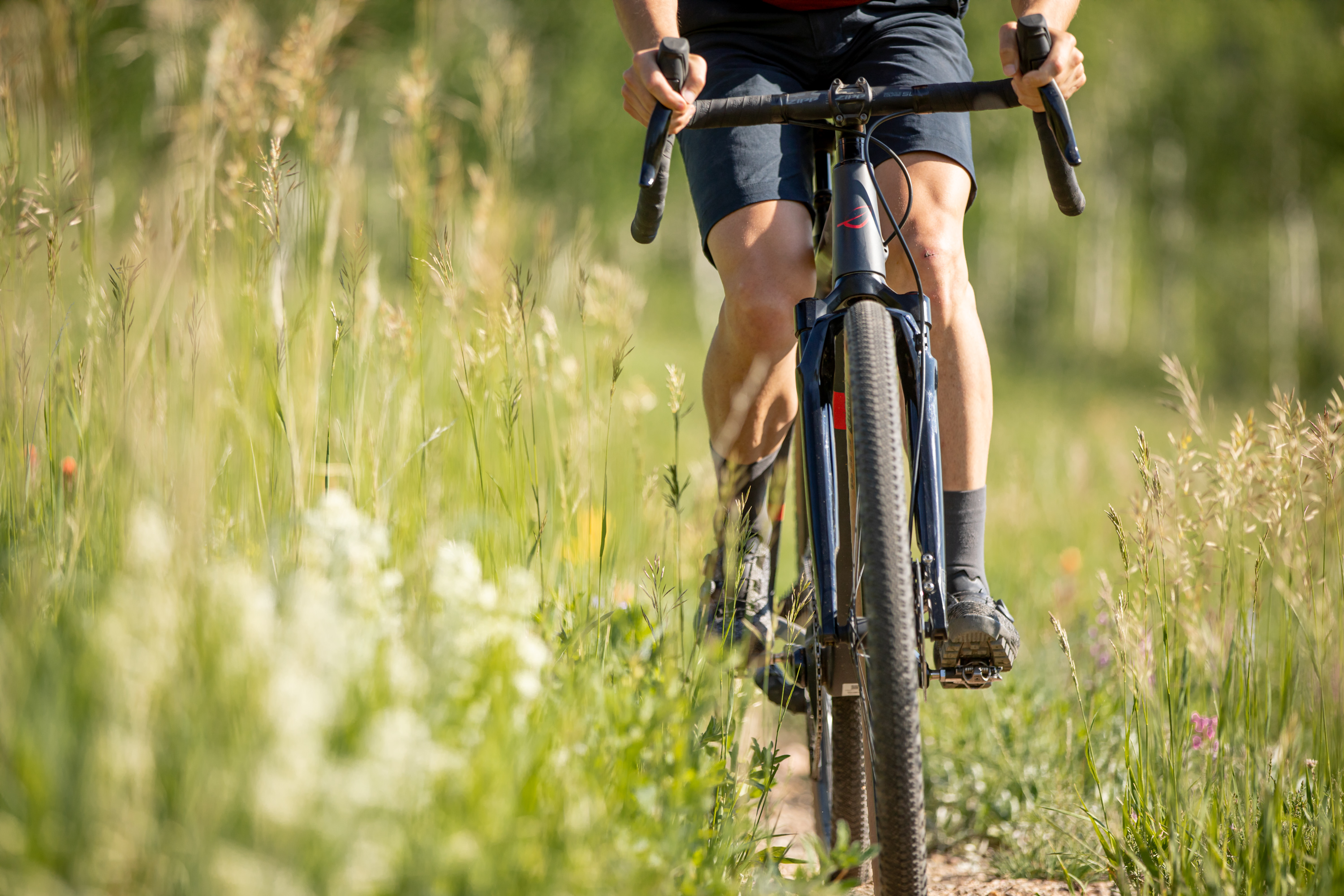SRAM, RockShox and Zipp launch XPLR: front suspension, dropper post, 1x gearing for gravel bikes
SRAM, RockShox and Zipp launch XPLR range to bolster gravel bike capabilities


SRAM, alongside its brands RockShox and Zipp, has launched a gravel bike ecosystem: XPLR.
Just in case the ‘isn’t a gravel bike a 90s mountain bike?’ crew didn't have enough ammunition, SRAM has upped the ante with the arrival of a short travel fork and dropper post for gravel bikes, via its brand RockShox.
The XPLR collection consists of a RockShox Rudy suspension fork, RockShox Reverb seatpost, SRAM XPLR 1x drivetrain with 10-44 cassette and a Zipp 101 wheelset, with existing tyres and handlebars gaining the SRAM XPLR branding.
The arrival had been anticipated, with Canyon’s rigid Grizl gravel bike being launched with a rating for a suspension fork, and SRAM equipped models notably absent within the line-up; the American brand owns RockShox and Zipp, positioning it for a total category takeover.
In line with the cycling industry's seeming continued attack against vowels, XPLR is pronounced ‘explore’.
RockShox XPLR Rudy fork

Our take on SRAM XPLR

Front suspension. Dropper posts. (Almost) mountain bike gears. Wheels designed to flex. Most of it sounds quite alien to a traditional road-focused audience. In the case of the suspension and dropper post, it’ll add around 1,020g to a bike and increase maintenance. If you’re not traversing the kind of off-road trails for which such systems are designed, it might sound like madness, and if you are, perhaps you’re bombing along on a hardtail. However, there is a segment in the middle for whom this setup might be exactly what the trails call for. Is it a tiny, niche, marginal part of the market? Probably, but that’s a risk for SRAM and its brands to account for.
In this instance, I'm going with 'don't knock it till you've tried it', and my test bike is currently being held up by the wonders of Brexit inspired customs, so I haven't tried it yet. But it will be here soon, with the South Downs Way as the intended playground.
Last month, Cycling Weekly's Stefan Abram completed the South Downs Way double, with a riding time of 19 hours, opting to ride a gravel bike. A SDW veteran, it was the hand and arm fatigue that really got to him, so with my own first attempt (at the single!) upcoming, I'm keen to see if the added squish of suspension could give me an advantage.
There will be riders out there who simply do not understand the addition of suspension on a gravel bike, if that’s you, you probably didn’t get past the headline. And we understand: suspension adds weight, maintenance, and if it’s required a hardtail mountain bike could be a more suitable option. However, we’re all for choice, and this new arrival certainly adds to the options, alongside the existing Fox AX fork and Lauf’s leaf sprung line-up.
The XPLR Rudy Fork (£799/$799) shares its genes with the RockShox Sid cross country fork, the focus has been on keeping additional weight to a minimum whilst offering a choice of 30mm or 40mm of travel.
The latest race content, interviews, features, reviews and expert buying guides, direct to your inbox!
The complete fork weighs between 1,300g, with the steerer uncut. The fork that came off the test bike I have on the way - a Salsa Warbird - weighed 549g, and my fork comes in at 1,225g, so in this case, the weight penalty is 676g.
The fork uses a Solo Air Spring, with the same Charger Race Day damper as seen on the Sid. Designed for those who want a firm ride with the lockout on, it’s meant to deliver exactly that, with Maxima Plush Dampening fluid aiming to reduce friction and provide a silent ride.
The Air Spring can be tuned with a shock pump, and rebound is adjusted with a 2.5mm Allen key.
SRAM has aimed for a slim profile, with a 30mm chassis, and it’s also chosen an alloy steerer and crown. Reportedly, opting for carbon dropped a few grams but added disproportionately to the price.
The fork is designed to work alongside a 700c wheel and a tyre up to 50mm tyre; SRAM says it hasn't designed this fork to pair with 650b wheels. Since most riders opting for the smaller wheel do so to add squish paired with a wider volume tyre, the brand argues the suspension will negate the need.
The Rudy fork comes with a 45mm offset, which will adjust the handling geometry. Reduced offset forks are something the mountain bike industry has been doing for some time, to help keep the wheelbase shorter to aid maneuverability and bring the rider’s weight over the front wheel.
The axle-to-crown height is 425mm on the 30mm travel option, and 435mm on the 40mm travel fork. On most gravel bikes, this comes in closer to 400mm, so again, swapping in the RockShox component will have a geometry ricochet effect, bringing the rider higher up.
In terms of maintenance, SRAM says that the fork will need a lower leg service after 50 hours, and a damper and air spring service after 200 hours. The fork uses 12x100mm thru axles, with flat mount discs - it’s suited to 160mm rotors, though 180mm options will work with an adapter, and comes with mudguard mounts for matching ‘fenders’.
- RockShox XPLR Rudy Fork
- 1,300g (steerer uncut)
- $799.00 €869.00 £779.00
RockShox XPLR Reverb dropper post

Check out the cross country bikes ridden in the Olympic race, and you’ll see that even weight conscious XC riders have stopped quibbling over the weight vs efficiency debate of dropper posts. Being able to banish the seatpost on techy descents has been awarded the winners status over cutting grams there, but it remains to be seen if gravel riders will be equally convinced.

Check out the cross country bikes ridden in the Olympic race, and you’ll see that even weight-conscious XC riders have stopped quibbling over the weight vs efficiency debate of dropper posts. Being able to banish the seatpost on techy descents has been awarded the winner's status over cutting grams there, but it remains to be seen if gravel riders will be equally convinced.
The RockShox AXS XPLR Reverb (£500/$600) post is an air-only system that weighs between 567 and 595g, for comparison, a Zipp Service Course SL Alloy seatpost comes in at 251g, so users will be adding around 344g with this component. The post measures 27.2mm, to suit the majority of frames, and comes in lengths of 350mm or 400mm, offering 50mm to 75mm of downward travel.
The system is best paired with SRAM eTap AXS drivetrains, it can be tuned via the accompanying app so that the double shift mechanism that would ordinarily change the chainring can operate the dropper for 1x riders. If that’s not up your street, you can also use a blip box, or, a flat bar lever - though this might not play nicely with a bar bag.
The battery used is the same as the SRAM AXS mechs (handy if you run out of juice on the mech, you can sacrifice your dropper).
Saddle clamp wise, it’s compatible with 7mm rails, 7x9mm oval rails; riders with 7x10mm oval rails will need to buy an adapter, the system is waterproof and dustproof to ‘IP69k’. As per any dropper post, you don’t want to be strapping anything to the upper portion, which might pull into question the use of a seatpost bag.
- Rockshox XPLR Reverb dropper post
- 350mm/400mm, 567g/595g
- $600.00 €600.00 £500.00
SRAM XPLR gearing

Whilst the RockShox suspension and dropper post are clearly going to take centre stage, it’s not all SRAM is unveiling this August. Enter: the SRAM XPLR 1x drivetrain, which, most notably, adds a 10-44T 12-speed cassette to proceedings - bridging between more road focused set ups, running 10-36, and the ‘mullet’ using Eagle’s mountain bike specific 10-50.
Available at SRAM Red, Force and Rival levels, the XPLR drivetrain will use a dedicated 1x compatible rear mech, which was made available as part of the Rival eTap AXS launch. Using SRAM’s ‘Mini cluster’ tech, the low gears remain tightly spaced - to suit fast sections - whilst the climbing cogs are spread wide, giving a 440% range.
The matching single ring, direct mount cranks are available as standard, or in a ‘wide’ variety, with a longer (DUB) crank spindle, compatible with 135, 142 and Boost spacing.
As per the Rival launch, the cranksets can be upgraded, to include a left arm power meter.
- SRAM XPLR Drivetrain components
- SRAM Red 1 crankset: 462g, $690/€700/£625.00
- SRAM Force 1 Crankset: 598g, $420/€435/£390
- SRAM Force 1 Wide Crankset: 604g, $420/€435/£390
- SRAM Rival 1 Wide Crankset: 706g, $130/€135/£120
- SRAM RED XPLR eTap AXS Rear Derailleur: 293g, $710/€685.00/£610.00
- SRAM Force XPLR eTap AXS Rear Derailleur: 308g, $490/€465/£415.00
- SRAM Rival XPLR eTap AXS Rear Derailleur: 327g, $255/€265/£236.00
- SRAM XPLR XG-1271 Cassette: 373g, $210/€225/£200.00
- SRAM XPLR XG-1251 Cassette: 412g, $150/€160/£145.00
Zipp 101 wheels

As the gravel trend has grown, so to have the claimed capabilities of wheelsets: most recent launches have been ‘all road’, or road and gravel worthy - including Zipp’s own 303S, 303 Firecrest and 353 NSW. But now, it’s added a gravel specific wheelset choice, again taking learnings from its mountain bike arsenal.
The Zipp 101 pinches a name used aeons ago in its slimmest profile road wheel, only this is a ‘moto’ inspired off-road creation. Like its enduro/trail wheelsets, these hoops pinch technology from automotive disciplines. The wheelsets use a single-wall rim, which intentionally flexes, to offer grip in the corners. The analogy Zipp uses is that of a runner rounding a sharp bend, their ankle turns to allow the movement, and these wheels are meant to provide the same effect.

The internal rim width is ever greater than the newest road versions, at 27mm, these are hookless and designed to run run with a tubeless tyre and sealant over tubes (though there’s nothing stopping you putting a tube in a compatible tubeless ready tyre).
The wheels feature a ZR1 hubset with steel cartridge bearings and a 6 pawl leaf spring driver mechanism, with 66 points of engagement - a higher number than you’d expect to see on the road. There’s 28 3-cross CX-Sprint spokes, front and rear.
Available in 650b or 700c sizes, these wheels aren’t especially light - coming in at 1,590g and 1,665g respectively.
The launch of the wheels comes alongside a rebranding of the Zipp G40 gravel tyre, to carry the XPLR logo, ditto the Service Course SL-70 handlebar with a 3 degree flare now carries the XPLR label.
- Zipp 101 XPLR wheelset
- 700c: 1,665g
- 650b: 1,590g
- RRP: $850/€ 870/£780 (front), $950/€ 970/£866.00 (rear) ($1,800/£1,646 pair)
Michelle Arthurs-Brennan the Editor of Cycling Weekly website. An NCTJ qualified traditional journalist by trade, Michelle began her career working for local newspapers. She's worked within the cycling industry since 2012, and joined the Cycling Weekly team in 2017, having previously been Editor at Total Women's Cycling. Prior to welcoming her first daughter in 2022, Michelle raced on the road, track, and in time trials, and still rides as much as she can - albeit a fair proportion indoors, for now.
Michelle is on maternity leave from April 2025 until spring 2026.
